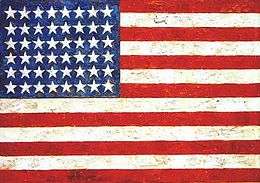Flag (painting)
Flag is an encaustic painting by the American artist Jasper Johns. Created when Johns was 24 (1954–55), two years after he was discharged from the US Army, this painting was the first of many works that Johns has said were inspired by a dream of the U.S. flag in 1954. It is arguably the painting for which Johns is best known.
 | |
|
|
The US flag was in the news repeatedly in 1954. The McCarthy hearings came to a close on 17 June 1954, only three days after Flag Day. On Flag Day, U.S. President Dwight D. Eisenhower signed an amendment to the pledge of allegiance to add the words "under God." The New York Times ran article on facts and myths associated with the flag on the day before Flag Day, and then an article on the "discipline" of the flag on Flag Day itself, saying, with reference to a national air-raid drill "we are all soldiers now". Francis Scott Key, composer of "The Star Spangled Banner", was born in 1779, exactly 175 years before 1954. The Iwo Jima Marine Memorial at Arlington National Cemetery, with its large US flag, was dedicated on 11 November 1954. Johns and his father were both named after Sergeant William Jasper, who saved the fallen flag of the Americans at Fort Moultrie in the American Revolutionary War.
The work measures 107.3 centimetres (42.2 in) by 153.8 centimetres (60.6 in). It is made using encaustic, oil paint, and newsprint collage on three separate canvases, mounted on a plywood board. The painting reflects the three colors of the US flag: red, white and blue; the flag is depicted in the form it took between 1912 and 1959, with 48 white stars on a blue canton representing the then-US states (excluding Alaska and Hawaii), and with thirteen red and white stripes. Newsprint is visible under the stripes. Reading the texts, it is clear that the newsprint was not selected at random: Johns steered clear of headlines, or national or political news, and used inconsequential articles or adverts. The painting has a rough-textured surface, and the 48 stars are not identical. It is dated 1954 on its reverse.
Johns's selection of the US flag allows him to explore a familiar two-dimensional object, with its simple internal geometric structure and a complex symbolic meaning. Johns was attracted to painting "things the mind already knows", and claimed that using a familiar object like the flag freed himself from the need to create a new design and allowed him to focus on the execution of the painting. Critics were unsure whether it was a painted flag or a painting of a flag; Johns later said it was both. His work is often described as Neo-Dadaist and anticipates aspects of pop art, minimal art, and conceptual art.
Johns made over 40 works based on the US flag, including a large and monochrome White Flag in 1955, and his 1958 work Three Flags with three superimposed flags showing a total of 84 stars.
In November 2014 the encaustic Flag (1983) was auctioned off for $36,000,000 at Sotheby's New York.
The painting was included in Johns's first solo exhibition at the Leo Castelli Gallery in early 1958. Alfred Barr, director of the Museum of Modern Art, wanted to buy the work, but was concerned that it might be considered unpatriotic. He persuaded a friend, Philip Johnson, to buy it instead; Johnson bought it, and donated it to the Museum of Modern Art "in honor of Alfred H. Barr, Jr." when he retired in 1968.
References
- Flag, Museum of Modern Art
- American Culture in The 1950s Martin Halliwell, p. 203-205
- Jasper Johns (born 1930), Metropolitan Museum of Art
- http://edu.warhol.org/app_johns.html
- Figuring Jasper Johns, Fred Orton, p. 89-146
- Made in U.S.A.: An Americanization in Modern Art, the '50s and '60s, Sidra Stich, p. 19
- The Target: Alain Robbe-Grillet, Jasper Johns, Ben Stoltzfus, p. 80-81